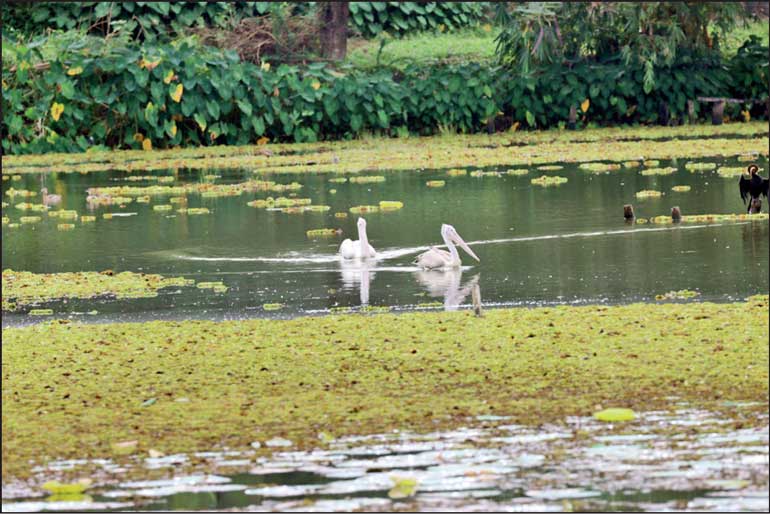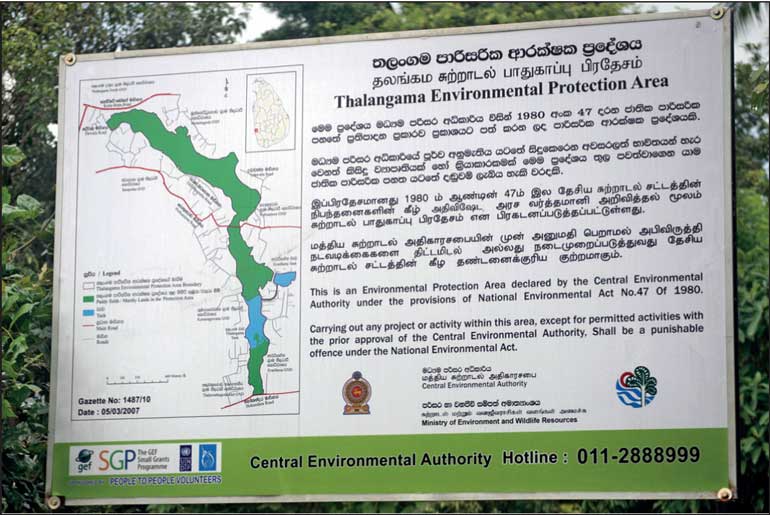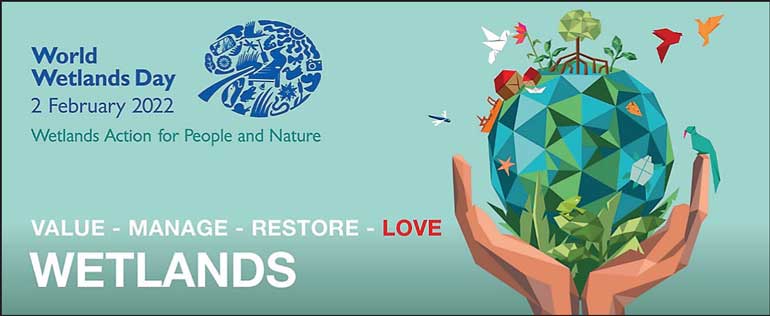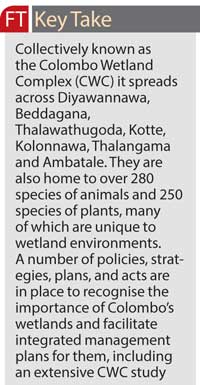Monday Apr 21, 2025
Monday Apr 21, 2025
Wednesday, 2 February 2022 00:00 - - {{hitsCtrl.values.hits}}



World Wetlands Day falls on 2 February, the date on which the Ramsar Convention on Wetlands was adopted in 1971, in Ramsar, a city in Iran. The Convention on Wetlands is an intergovernmental treaty which provides the framework for national action and international cooperation for the conservation and wise use of wetlands and their resources. 170 countries have ratified the Ramsar Convention (including Sri Lanka in 1990), and over 2,300 Ramsar sites with a total surface area of 252 million hectares have been declared.
1971, in Ramsar, a city in Iran. The Convention on Wetlands is an intergovernmental treaty which provides the framework for national action and international cooperation for the conservation and wise use of wetlands and their resources. 170 countries have ratified the Ramsar Convention (including Sri Lanka in 1990), and over 2,300 Ramsar sites with a total surface area of 252 million hectares have been declared.
2 February 2022 is the first year that World Wetlands Day will be observed as a United Nations international day, following its adoption by the General Assembly on 30 August 2021. The theme for the 2022 edition is Wetlands Action for People and Nature, and it highlights the importance of actions that ensure that wetlands are conserved and sustainably used. It’s an appeal to invest financial, human and political capital to save the world’s wetlands from disappearing and to restore those we have degraded.
In October 2018, the 13th Conference of the Parties to the Ramsar Convention unveiled the first 18 cities that were chosen world-wide: and Colombo is the only South Asian city and the only capital among them. Rebranding cities as wetland cities under the Ramsar Wetland Accreditation scheme is an initiative that began in 2012. Accordingly, cities located in the vicinity of wetlands and dependent on wetlands are encouraged to utilise urban and peri-urban wetlands sustainably. Colombo is not merely a city that happens to be near wetlands. It is not merely a city surrounded by wetlands. Since its founding at the heart of the Kelani River delta, wetlands have been an integral part of Colombo, and it is not possible to think of the city without them.
Collectively known as the Colombo Wetland Complex (CWC) it spreads across Diyawannawa, Beddagana, Thalawathugoda, Kotte, Kolonnawa, Thalangama and Ambatale. They are also home to over 280 species of animals and 250 species of plants, many of which are unique to wetland environments. A number of policies, strategies, plans, and acts are in place to recognise the importance of Colombo’s wetlands and facilitate integrated management plans for them, including an extensive CWC study in 2015 and the Wetland Management Strategy 2016.
strategies, plans, and acts are in place to recognise the importance of Colombo’s wetlands and facilitate integrated management plans for them, including an extensive CWC study in 2015 and the Wetland Management Strategy 2016.
Why recreate, when you can protect? Wetlands currently cover about 20 square kilometres of the Colombo Metropolitan Area, but they have been degraded and lost at a rate of 1.2% (58 acres) per year. In some parts of the city, up to 60% of wetland extent has been lost since the 1980s. The main reasons for this are solid waste dumping, untreated domestic wastewater, invasive species, algal blooms downstream from farms, and indiscriminate land filling.
The CWC provides refuge for 39% of the storm water – storing and then slowly releasing the excess water over a long period of time. In doing so the wetlands help maintain soil moisture balance. More than 50% of the city falls within the catchment of the CWC, which provides Colombo with green lungs allowing Colombo to enjoy a kind of natural air conditioning. Colombo’s wetlands act as a buffer by trapping and removal of particulate matter in the air. It cools the city, cleans its water and air, protects it from flooding, and improves human quality of life. This has direct health benefits for the city’s inhabitants – the wetlands reduce the incidence of cardiopulmonary and respiratory diseases, coughing, bronchitis, and lung cancer.
direct health benefits for the city’s inhabitants – the wetlands reduce the incidence of cardiopulmonary and respiratory diseases, coughing, bronchitis, and lung cancer.
The Thalangama wetland is home to two man-built reservoirs (tanks) namely Thalangama Tank and Averihena Tank, both just 300 metres apart and is protected by a Gazette in which the only permitted uses are fishing, birdwatching and cultivation. It is the duty of the Minister of Environment and the CEA to defend this gazette and these wetlands from the proposed elevated highway which the RDA is attempting to bull-doze through over 3 km of this Environmental Protected area. Residents had to rush to court with a Writ to defend this gazette. But what did the Minister then do? He surreptitiously publishes an amendment to this Gazette including “Elevated Highways” under “permitted uses”! It will be very interesting to read the Minister’s message on World Wetlands Day.
The designation of Colombo as a Ramsar Wetland City is a milestone achievement and an incredible opportunity to double down on measures to protect and restore the city’s wetlands. With increased public awareness, international support, and combined government and citizen action, Colombo can embrace its green infrastructure and the advantages of urban wetlands. Preserving Colombo’s wetlands is a long-term investment in sustainable urban infrastructure that will pay off in many ways. Very soon, Sri Lanka will have to justify the retention of Colombo’s Wetland City status. Till then, it is up to all stakeholders to work toward this goal and make the city a global leader in wetland conservation.
“Misconception of development as synonymous to large-scale infrastructure development programs at the cost of the environment is one of the largest threats to our wetlands right now. While the right to development is unarguably important, policy making should not be clouded with the misconception of developing now and cleaning up later.”
(The writer is the CEO of a corporate entity and enjoys offering perspectives on social issues in the hope that it will inspire change and not controversy.)
Discover Kapruka, the leading online shopping platform in Sri Lanka, where you can conveniently send Gifts and Flowers to your loved ones for any event including Valentine ’s Day. Explore a wide range of popular Shopping Categories on Kapruka, including Toys, Groceries, Electronics, Birthday Cakes, Fruits, Chocolates, Flower Bouquets, Clothing, Watches, Lingerie, Gift Sets and Jewellery. Also if you’re interested in selling with Kapruka, Partner Central by Kapruka is the best solution to start with. Moreover, through Kapruka Global Shop, you can also enjoy the convenience of purchasing products from renowned platforms like Amazon and eBay and have them delivered to Sri Lanka.
Discover Kapruka, the leading online shopping platform in Sri Lanka, where you can conveniently send Gifts and Flowers to your loved ones for any event including Valentine ’s Day. Explore a wide range of popular Shopping Categories on Kapruka, including Toys, Groceries, Electronics, Birthday Cakes, Fruits, Chocolates, Flower Bouquets, Clothing, Watches, Lingerie, Gift Sets and Jewellery. Also if you’re interested in selling with Kapruka, Partner Central by Kapruka is the best solution to start with. Moreover, through Kapruka Global Shop, you can also enjoy the convenience of purchasing products from renowned platforms like Amazon and eBay and have them delivered to Sri Lanka.